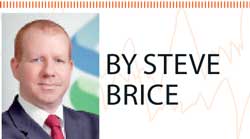02 Aug 2017 - {{hitsCtrl.values.hits}}
 A recurring theme among some market observers is how complacent the equity investors are today. A statistic often used as evidence is the US S&P 500 market-implied volatility or VIX, index. When this is low, it usually signals that investors are sanguine about the outlook for stocks. Therefore, some use the VIX index as a contrarian indicator to hedge their downside risk. Thus, when the VIX index fell below 10 during a few trading sessions in May for the first time since 2007, some thought it was flashing a warning sign for equity investors.
A recurring theme among some market observers is how complacent the equity investors are today. A statistic often used as evidence is the US S&P 500 market-implied volatility or VIX, index. When this is low, it usually signals that investors are sanguine about the outlook for stocks. Therefore, some use the VIX index as a contrarian indicator to hedge their downside risk. Thus, when the VIX index fell below 10 during a few trading sessions in May for the first time since 2007, some thought it was flashing a warning sign for equity investors.
If only life were so simple - if we could all rely on just one indicator to determine the outlook for global equities! As one would expect, the truth is much more complex.
Indeed, we believe there may be greater complacency in the bond markets than in equity markets. While bond yields remain depressed wherever you look in the bond universe, investors are still flocking to invest in bond markets. However, many of the key long-term drivers that have pushed yields lower – namely globalisation, China’s industrialisation, urbanisation and demographics which created excess savings – may be reversing. Meanwhile, the US economy is clearly closing on supply side constraints that could put upward pressure on inflation and bond yields as the Fed continues to hike interest rates. This could prove to be a bigger challenge for bond investors, than the low VIX index is for stock investors, going forward.
But first, let’s address the weakness of the VIX index as a signalling tool. In July 2005, the VIX index fell below 10, but the S&P500 index went on to rise another 25 percent before peaking in October 2007. The VIX also slipped below 10 in November 2006 before an 11.5 percent rally to the same peak. It again dipped below 10 in 1Q 2007, well before the market’s peak in October that year. Naturally, these ascents were not smooth, but the investors who held on after the drop in volatility, through the ensuing one to two years, were well rewarded.
Now, let’s move on to other factors that suggest investors may be less complacent than the VIX index suggests. The global fund managers’ surveys are a good place to start. One of the questions fund managers are asked is the level of cash holdings in their portfolios. The higher the percentage, the more bullish the signal as it means there is more money on the sidelines waiting to be invested. Given the size of potential flows, this should limit the downside for equity markets.
According to some estimates, a level of cash holdings above 4.5 percent is normally a buy signal for equities and holdings below 3.5 percent is a sell-signal. Currently, this indicator is at 4.9 percent, not as strong a buy signal as late last year when it was above 5.5 percent but still far from ‘complacent’ levels.
Meanwhile, there are very few signs of complacency when it comes to retail investors, at least in our major markets of Asia, Africa and the Middle East.
As we headed into 2017, we took the view that the pivot towards a more reflationary economic environment – one epitomised by modestly stronger global growth and slightly higher inflation – would be positive for equities. While we were not outright bond bears, we recommended an increased allocation to equities at the expense of a reduced allocation to bonds. Global equities have returned almost 15 percent year-to-date (as of end-July) and a key global bond index has risen close to 6 percent.
However, the vast majority of client flows into mutual funds so far this year has been into bonds. Indeed, even where clients have been investing in equities, this has largely been as part of a multi-asset income approach to investing, which focuses on the high dividend yielding part of the equity market, not normally an area (outside of Asia at least) that is likely to benefit the most from a reflationary outlook.
This is another reason why we believe there may be greater complacency in the bond markets than in equity markets.
Of course, there are always creative ways to try to enhance bond returns and mitigate the risk of interest rate hikes – picking bonds with shorter maturity profiles or with higher yields (and lower credit quality) – and this is why we have been highlighting our preference for Emerging Market USD-denominated bonds and the less interest rate-sensitive US floating rate senior loans. However, some of the longer term structural drivers of the bond market may be turning against it, which could prove to be a challenge for bond investors.
It is quite possible that a pullback in bonds (leading to higher bond yields) may also cause some digestion challenges for equity markets at some point over the summer months. Still, we continue to expect the global economy to remain healthy over the next 12 months, and this should keep equity markets in a continued bull market for some time to come.
(Steve Brice is Chief Investment Strategist at Standard Chartered
Private Bank)
25 Nov 2024 11 minute ago
25 Nov 2024 29 minute ago
25 Nov 2024 54 minute ago
25 Nov 2024 1 hours ago
25 Nov 2024 2 hours ago